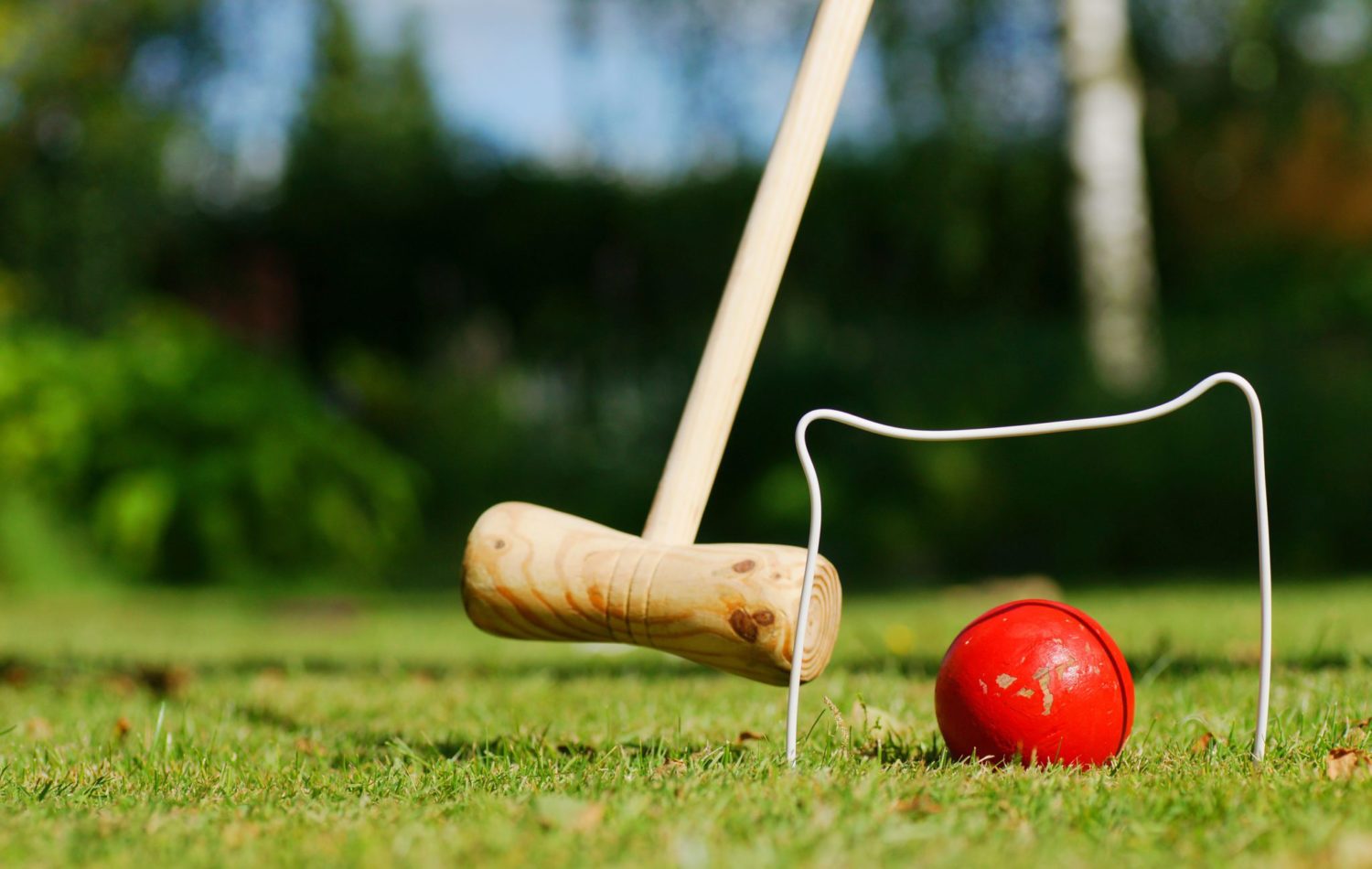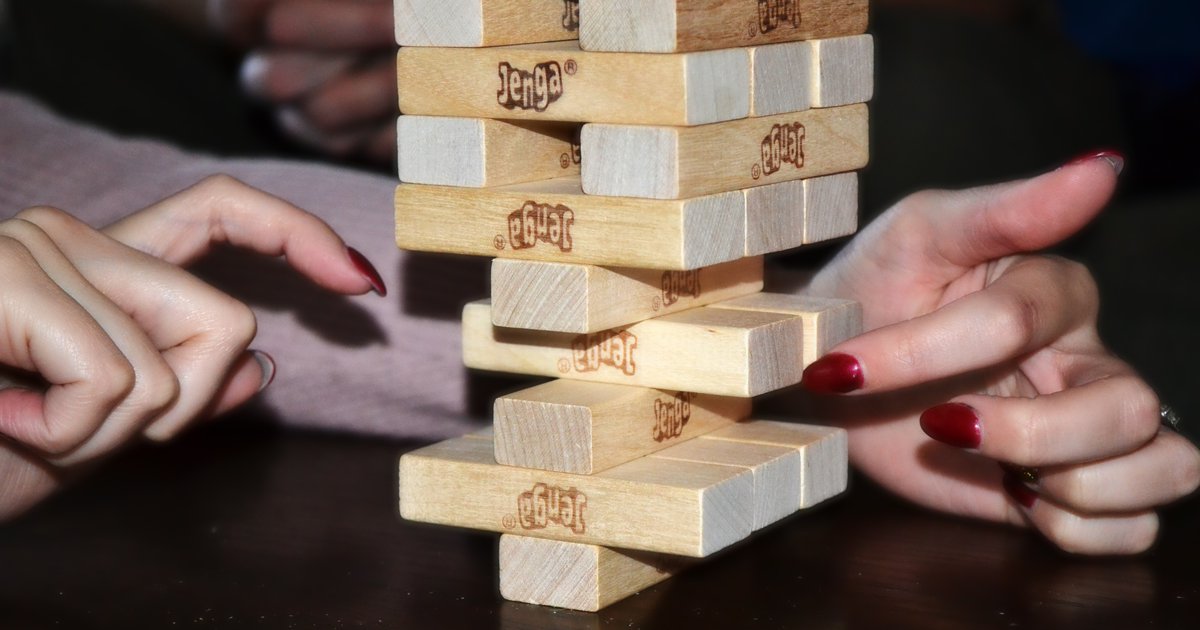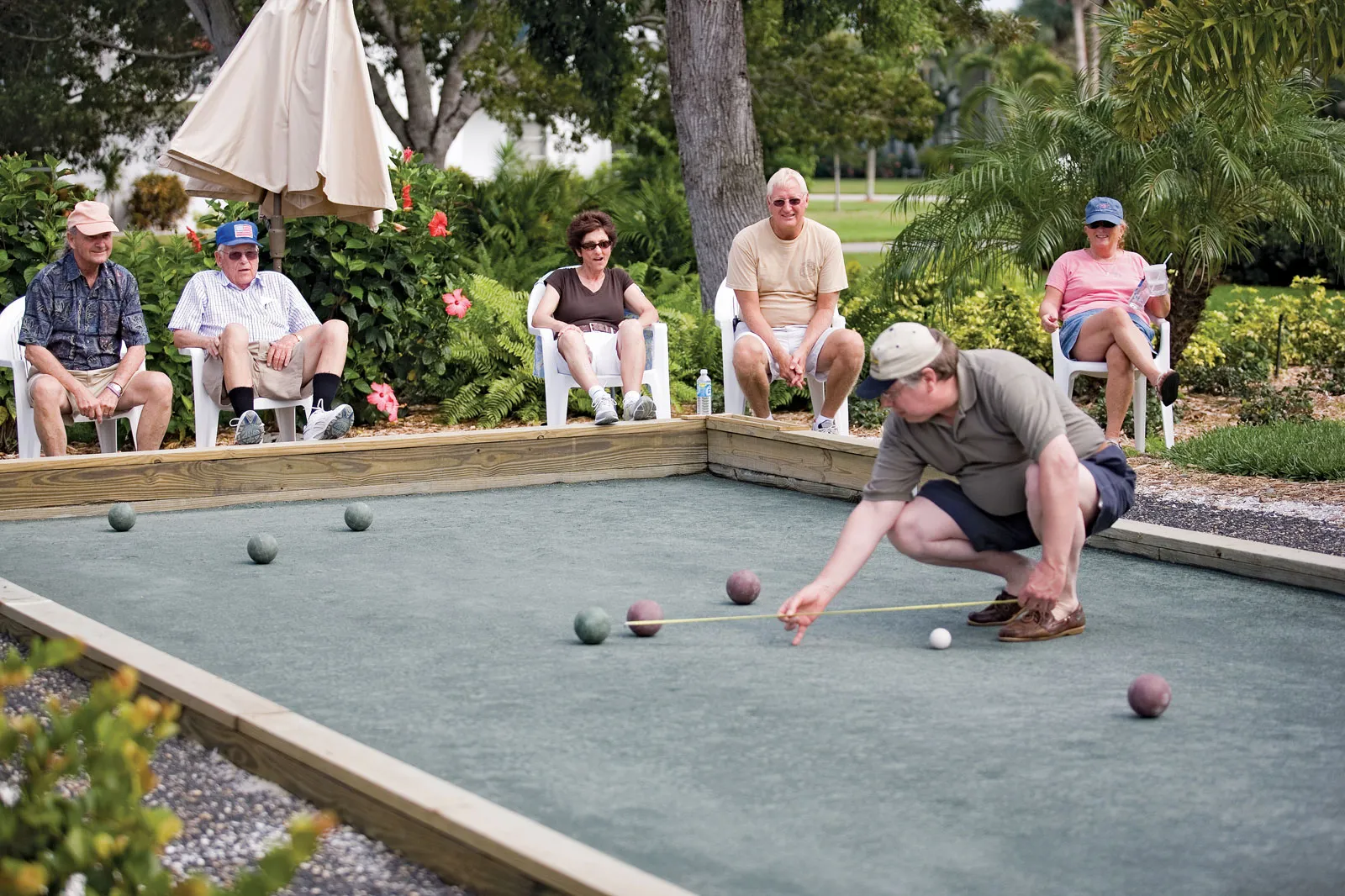Home>Gardening & Outdoor>Outdoor Recreation & Activities>How To Play Croquet


Outdoor Recreation & Activities
How To Play Croquet
Modified: April 21, 2024
Learn how to play croquet and enjoy this classic outdoor recreation and activity. Discover the rules, techniques, and tips for a fun and competitive game. Start your croquet adventure today!
(Many of the links in this article redirect to a specific reviewed product. Your purchase of these products through affiliate links helps to generate commission for Storables.com, at no extra cost. Learn more)
Introduction
Croquet is a delightful outdoor game that combines elements of strategy, precision, and friendly competition. Originating in the 19th century, this game has evolved into a beloved pastime for people of all ages. Whether you're hosting a backyard gathering, enjoying a leisurely afternoon at the park, or participating in a competitive tournament, croquet offers a perfect blend of relaxation and excitement.
The game is typically played on a grassy lawn, where players take turns using a mallet to hit colored balls through a series of wickets embedded in the ground. The objective is to navigate the course and be the first to strike the finishing stake, all while strategically maneuvering to hinder opponents' progress. With its simple yet engaging premise, croquet provides an ideal opportunity for socializing and enjoying the great outdoors.
As a versatile activity, croquet can be tailored to suit various skill levels and preferences. Whether you're a novice seeking a casual pastime or a seasoned player aiming to refine your techniques, the game offers ample room for growth and enjoyment. Additionally, the rules are straightforward, making it accessible to newcomers while still allowing for strategic depth that keeps experienced players engaged.
The beauty of croquet lies not only in its gameplay but also in the camaraderie it fosters. Gathering with friends and family to engage in a lighthearted match can create cherished memories and strengthen bonds. The gentle clinking of mallets, the satisfying thud of a well-struck ball, and the laughter that accompanies each turn all contribute to the convivial atmosphere that surrounds this timeless game.
In the following sections, we will delve into the essential equipment needed to play croquet, the process of setting up the croquet court, basic rules and objectives of the game, as well as techniques and strategies to enhance your skills. Whether you're a newcomer or a seasoned player looking to refine your approach, this guide will provide valuable insights to elevate your croquet experience. So, grab your mallet, step onto the lush green expanse, and let's embark on a journey into the captivating world of croquet.
Key Takeaways:
- Croquet is a fun outdoor game that combines strategy and friendly competition. It’s easy to set up and offers a chance to socialize while enjoying the great outdoors.
- Mastering the art of holding and swinging the mallet, along with learning basic shots and advanced strategies, can help players navigate the croquet course with precision and finesse.
Read more: How To Play Croquet For Beginners
Equipment Needed
To embark on a thrilling game of croquet, you'll need a few essential pieces of equipment. These items are fundamental to the game and contribute to the overall enjoyment and competitiveness of each match. Here's a breakdown of the equipment required to set the stage for an exhilarating croquet experience:
-
Mallets: A set of croquet mallets is indispensable for players to maneuver the balls across the course. These mallets typically feature a cylindrical wooden shaft and a solid head, often made of hardwood. The weight and length of the mallet can vary, catering to different age groups and skill levels. Each player should have their own mallet, and it's crucial to select one that feels comfortable and well-balanced for optimal control and accuracy.
-
Balls: The game of croquet involves the use of colored balls, each representing a player or team. Traditionally, the set includes six balls in distinct colors, such as blue, red, black, yellow, green, and orange. These vibrant balls not only add a visual appeal to the game but also serve as the focal point of strategic maneuvers and tactical plays.
-
Wickets: Wickets, also known as hoops, are essential components that define the course and guide the movement of the balls. Typically made of metal, these U-shaped structures are strategically positioned throughout the playing area, creating a challenging path for the players to navigate. The number of wickets can vary depending on the variant of croquet being played, with each wicket presenting a unique obstacle to overcome.
-
Stakes: At the heart of the croquet court stands the finishing stake, a sturdy post that serves as the ultimate target for players to aim for. This pivotal element marks the culmination of the game, as players strive to skillfully position their balls in proximity to the stake to secure victory. The stake is often adorned with a colored cap to distinguish it from the wickets and enhance visibility.
-
Court Marking Flags: To delineate the boundaries of the playing area and indicate the positioning of wickets and the finishing stake, court marking flags are employed. These flags are typically brightly colored and are placed at strategic points along the perimeter of the court, ensuring that players can easily discern the layout of the course and plan their moves accordingly.
-
Measuring Tape: Precision is paramount in croquet, and a measuring tape is indispensable for accurately setting up the court according to the official dimensions. This tool ensures that the wickets are evenly spaced and aligned, maintaining fairness and consistency in the gameplay.
By assembling these fundamental components, you can establish a well-equipped croquet court and set the stage for an engaging and competitive match. Each piece of equipment plays a crucial role in shaping the dynamics of the game, offering players the opportunity to showcase their skills and strategic prowess amidst the scenic backdrop of the playing field.
Setting Up the Croquet Court
Setting up the croquet court is a pivotal aspect of preparing for an exhilarating game. The careful arrangement of the playing area not only ensures fairness and consistency but also contributes to the overall aesthetic appeal of the game. Here's a comprehensive guide to setting up the croquet court, from marking the boundaries to positioning the wickets and stake.
Selecting the Playing Area
Before delving into the specifics of court setup, it's essential to choose an appropriate location for the game. Ideally, the playing surface should be a level, grassy expanse free of any obstructions or uneven terrain. The dimensions of the court can vary based on the available space and the desired level of challenge. A standard croquet court measures 50 feet by 100 feet, but adjustments can be made to accommodate different skill levels and playing environments.
Marking the Boundaries
Using the measuring tape, mark the boundaries of the court with court marking flags. The corners of the court should be clearly defined, ensuring that the playing area is symmetrical and well-defined. This step is crucial for maintaining the integrity of the game and providing players with a clear understanding of the court's layout.
Read more: How To Win At Croquet
Placing the Wickets
Position the wickets along the court according to the specific variant of croquet being played. For the traditional nine-wicket croquet, the wickets are arranged in a double-diamond pattern, with one stake placed at each end of the court. The wickets should be evenly spaced and aligned to create a challenging yet balanced course. Careful attention to detail during this phase sets the stage for an engaging and competitive gameplay experience.
Positioning the Finishing Stake
At the center of the court, place the finishing stake, ensuring that it is equidistant from the two shorter boundaries. The stake should be firmly anchored into the ground, standing as a prominent focal point that beckons players to strive for victory. Its strategic placement adds a layer of complexity to the game, as players must skillfully navigate their balls to reach this pivotal target.
By meticulously setting up the croquet court, you establish the foundation for an enthralling and fair game. The precision and care invested in this process contribute to the overall enjoyment and competitiveness of the match, creating an inviting space for players to showcase their skills and immerse themselves in the timeless allure of croquet.
Basic Rules and Object of the Game
In the enchanting realm of croquet, understanding the basic rules and the overarching objective is paramount to fully immerse oneself in the game. At its core, the objective of croquet is to guide your ball through a series of wickets in a prescribed order and ultimately strike the finishing stake before your opponents. This seemingly simple premise belies the strategic depth and tactical finesse that define the game. Let's delve into the fundamental rules and the captivating objective that drive the exhilarating gameplay of croquet.
Object of the Game
The primary objective in croquet is to navigate your ball through the course, passing through each of the assigned wickets in a specific sequence. This sequence may vary based on the chosen variant of the game, but the ultimate goal remains consistent: to be the first player or team to strike the finishing stake. This culminating action, known as "pegging out," signifies the successful completion of the course and heralds victory for the adept player who achieves this feat.
Read more: When Was Croquet Invented?
Gameplay Dynamics
The game typically begins with each player or team selecting a colored ball, with the order of play determined by a designated starting point. Players take turns striking their balls with the mallet, aiming to advance through the wickets while strategically positioning their opponents' balls to impede their progress. This interplay of offensive maneuvers and defensive tactics adds an intriguing layer of complexity to the game, fostering a dynamic and engaging experience for all participants.
Basic Rules
Several fundamental rules govern the gameplay of croquet, ensuring fairness and sportsmanship throughout the match. Players must adhere to the following guidelines:
-
Order of Play: The order of play is established at the beginning of the game and is typically maintained throughout the match, with each player taking turns to strike their ball.
-
Striking Sequence: Players must navigate their balls through the wickets in the designated order, ensuring that they pass through each wicket before proceeding to the next.
-
Roquet and Continuation Shots: When a player's ball strikes another ball, a roquet is declared, allowing the striking player to take an additional shot, known as a continuation shot. This sequence of shots enables players to strategically position their balls and gain a competitive advantage.
-
Deadness and Clearing: A ball becomes "dead" on striking another ball, rendering it temporarily inactive. Clearing a dead ball involves striking it to reactivate its participation in the game.
-
Pegging Out: The pivotal moment of pegging out occurs when a player successfully navigates their ball through all the wickets and strikes the finishing stake, securing victory and concluding the game.
By embracing these fundamental rules and embracing the overarching objective of the game, players can fully immerse themselves in the captivating world of croquet, where strategic prowess and tactical finesse converge to create an enthralling and memorable experience.
How to Hold and Swing the Mallet
Mastering the art of holding and swinging the croquet mallet is fundamental to achieving precision and control in the game. The proper grip and technique not only enhance the accuracy of your shots but also contribute to the fluidity and finesse of your gameplay. Here's a comprehensive guide on how to hold and swing the mallet, empowering you to elevate your croquet skills and immerse yourself in the captivating dynamics of the game.
Holding the Mallet
The first step in wielding the croquet mallet with proficiency is to adopt a suitable grip. Begin by positioning your dominant hand at the top of the mallet's handle, ensuring a firm yet comfortable hold. The fingers should encircle the handle, providing stability and control without exerting excessive pressure. As you grasp the mallet, maintain a relaxed posture, allowing for fluid movement and swift adjustments during gameplay.
Simultaneously, your non-dominant hand should rest on the shaft of the mallet, providing additional support and balance. This hand serves as a guiding force, facilitating the alignment and trajectory of your shots. By coordinating the positioning of both hands, you can achieve a harmonious and effective grip that forms the foundation for proficient mallet manipulation.
Read more: What Are The Rules Of Croquet?
Swinging the Mallet
The art of swinging the croquet mallet encompasses a blend of finesse and power, culminating in precise and impactful strikes. As you prepare to execute a shot, position your body in alignment with the target, maintaining a stable and balanced stance. The mallet should be poised and ready, with your hands positioned to facilitate a fluid and controlled swing.
Initiate the swing by drawing the mallet back in a smooth and controlled motion, harnessing the momentum to generate power. As the mallet approaches the point of impact, ensure that your wrists remain supple, allowing for a seamless transfer of energy from your body to the mallet. The striking action should be decisive yet fluid, with the mallet making contact with the ball at the optimal angle and velocity to achieve the desired outcome.
Throughout the swing, focus on maintaining a steady and fluid motion, harnessing the kinetic energy to propel the ball with accuracy and intent. By honing your swinging technique and cultivating a harmonious synergy between body and mallet, you can unleash the full potential of your shots, navigating the course with finesse and strategic acumen.
Embracing the nuances of holding and swinging the croquet mallet empowers players to elevate their gameplay, infusing each shot with precision and intent. By honing these fundamental skills, you can embark on a captivating journey through the world of croquet, where strategic prowess and technical finesse converge to create an enthralling and memorable experience.
Basic Shots and Strategies
In the enchanting realm of croquet, mastering the fundamental shots and strategies is essential to navigate the course with finesse and outmaneuver opponents. Each shot presents a unique opportunity to strategically position your ball, impede your rivals' progress, or set the stage for a decisive play. Let's explore the essential shots and strategic maneuvers that define the captivating dynamics of croquet gameplay.
1. Clearing Shot
The clearing shot is a foundational maneuver aimed at propelling your ball through the course while strategically positioning it for subsequent plays. This shot involves navigating your ball through a wicket, thereby clearing the immediate area and setting the stage for advanced tactical maneuvers. A well-executed clearing shot not only advances your position but also lays the groundwork for subsequent offensive or defensive plays.
2. Split Shot
The split shot is a strategic maneuver that involves striking your ball to position it in proximity to an opponent's ball, creating a potential obstacle for their next turn. By skillfully executing a split shot, you can disrupt your opponents' planned trajectory, forcing them to adapt their strategy and navigate around the strategically placed balls. This maneuver introduces an element of tactical finesse, allowing you to exert influence over the dynamics of the game.
Read more: What Is Croquet? (The Game)
3. Defensive Placement
Strategic defensive placement involves positioning your ball in a manner that obstructs your opponents' progress or limits their available options. By leveraging defensive placement, you can impede your rivals' advancement through the course, forcing them to navigate around your strategically positioned ball. This defensive tactic introduces an element of strategic foresight, enabling you to shape the flow of the game and assert your influence over the playing field.
4. Roquet and Continuation Shots
The roquet, which occurs when your ball strikes another ball, sets the stage for continuation shots, allowing you to strategically position your ball and gain a competitive advantage. By skillfully executing roquet and continuation shots, you can orchestrate intricate plays that not only advance your position but also disrupt your opponents' planned maneuvers. This sequence of shots introduces a layer of strategic depth, enabling you to orchestrate complex plays and outmaneuver your rivals.
5. Offensive Maneuvers
Strategic offensive maneuvers involve navigating your ball to advantageous positions, setting the stage for decisive plays and positioning yourself for a successful peg-out. By deftly orchestrating offensive maneuvers, you can assert control over the course, strategically positioning your ball to capitalize on opportunities and propel yourself closer to victory. This strategic approach introduces an element of calculated risk, enabling you to seize opportunities and propel yourself toward the finishing stake.
By embracing these fundamental shots and strategic maneuvers, players can immerse themselves in the captivating world of croquet, where strategic acumen and tactical finesse converge to create an enthralling and memorable experience. Each shot presents an opportunity to shape the course of the game, fostering a dynamic and engaging gameplay experience that rewards strategic prowess and calculated decision-making.
Advanced Techniques and Tips
In the realm of croquet, mastering advanced techniques and honing strategic acumen elevates players to new heights of skill and proficiency. These advanced maneuvers and tactical insights empower players to navigate the course with finesse, outmaneuver opponents, and orchestrate decisive plays. Here, we delve into a compendium of advanced techniques and invaluable tips that unlock the full potential of croquet gameplay.
Read more: How To Set Up A Croquet Game
1. Split-Roll Shots
The split-roll shot is a sophisticated maneuver that involves striking your ball with the mallet to navigate it through a wicket while simultaneously positioning it to continue its trajectory toward the next strategic point on the course. This advanced technique requires precise control and strategic foresight, enabling players to seamlessly transition from clearing a wicket to setting the stage for subsequent plays.
2. Controlled Break Placement
Strategic break placement involves orchestrating a sequence of shots to position your ball and potentially displace opponents' balls, creating a strategic advantage. By meticulously planning and executing controlled break placement, players can disrupt opponents' planned maneuvers, assert influence over the course, and set the stage for a decisive push toward the finishing stake.
3. Defensive Stance Maneuvers
Mastering defensive stance maneuvers allows players to strategically position their ball in a manner that not only obstructs opponents' progress but also creates a formidable defensive barrier. By leveraging defensive stance maneuvers, players can fortify their position on the course, compelling opponents to navigate around strategically placed balls and paving the way for a strategic offensive counterplay.
4. Precision Roquets and Follow-Through Shots
Executing precision roquets and follow-through shots involves striking your ball with the mallet to precisely position it in proximity to opponents' balls, setting the stage for intricate follow-through plays. This advanced technique requires finesse and strategic calculation, enabling players to orchestrate complex sequences of shots that disrupt opponents' strategies and advance their own position with precision and intent.
Read more: How Many Wickets In A Croquet Set?
5. Strategic Ball Placement for Peg-Out
Strategic ball placement for peg-out involves positioning your ball in proximity to the finishing stake, setting the stage for a decisive push toward victory. By strategically maneuvering their balls into optimal positions, players can capitalize on opportunities to secure victory, orchestrating a calculated approach that culminates in a triumphant peg-out.
Invaluable Tips for Advanced Gameplay
- Strategic Anticipation: Anticipate opponents' moves and plan your shots to strategically position your ball and disrupt their gameplay.
- Adaptive Tactics: Adapt your tactics based on the evolving dynamics of the game, leveraging advanced techniques to capitalize on strategic opportunities.
- Meticulous Planning: Plan your shots with precision, considering the potential outcomes and strategically positioning your ball to gain a competitive advantage.
- Strategic Patience: Exercise strategic patience, waiting for opportune moments to execute advanced maneuvers that shape the course of the game.
By embracing these advanced techniques and invaluable tips, players can unlock the full potential of croquet gameplay, immersing themselves in a world of strategic acumen and tactical finesse. Each advanced maneuver and strategic insight presents an opportunity to elevate the gameplay experience, fostering a dynamic and engaging environment where skill and proficiency converge to create enthralling and memorable matches.
Conclusion
In conclusion, croquet stands as a timeless and captivating outdoor game that seamlessly blends strategic acumen, tactical finesse, and convivial camaraderie. From the meticulous setup of the court to the exhilarating gameplay dynamics, croquet offers a multifaceted experience that appeals to players of all ages and skill levels. As the gentle clinks of mallets and the vibrant hues of the balls adorn the lush green expanse, a sense of camaraderie and friendly competition permeates the air, creating an inviting space for socializing and leisurely enjoyment.
Throughout this guide, we have explored the essential equipment needed to embark on a thrilling game of croquet, from the iconic mallets and colorful balls to the strategically positioned wickets and finishing stake. The meticulous setup of the croquet court serves as the canvas for an enthralling match, where players can showcase their skills and immerse themselves in the strategic depth of the game.
Understanding the basic rules and objectives of croquet lays the groundwork for an engaging and competitive gameplay experience. The interplay of offensive maneuvers, defensive tactics, and strategic positioning adds a layer of complexity to the game, fostering an environment where players can exercise their strategic prowess and tactical finesse.
Delving into the nuances of holding and swinging the mallet, as well as mastering basic shots and advanced techniques, empowers players to navigate the course with precision and intent. Each shot presents an opportunity to shape the dynamics of the game, fostering a dynamic and engaging gameplay experience that rewards strategic acumen and calculated decision-making.
As players gather on the verdant expanse to partake in a spirited game of croquet, they not only engage in a delightful pastime but also forge lasting memories and strengthen bonds. The gentle competition and lighthearted banter that accompany each turn create an atmosphere of conviviality and shared enjoyment, underscoring the social appeal of this beloved outdoor game.
In essence, croquet transcends mere gameplay, offering a holistic experience that celebrates the joy of outdoor recreation, the thrill of friendly competition, and the warmth of communal interaction. Whether played in a casual backyard setting, a serene park, or a competitive tournament, croquet embodies the timeless allure of outdoor leisure, inviting players to revel in the simple pleasures of skillful play and convivial camaraderie.
Frequently Asked Questions about How To Play Croquet
Was this page helpful?
At Storables.com, we guarantee accurate and reliable information. Our content, validated by Expert Board Contributors, is crafted following stringent Editorial Policies. We're committed to providing you with well-researched, expert-backed insights for all your informational needs.










0 thoughts on “How To Play Croquet”